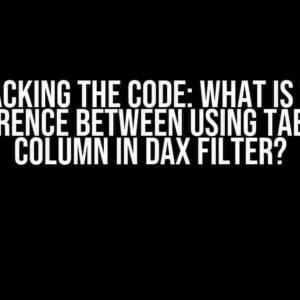Are you tired of feeling overwhelmed when working with did_multiplegt_dyn and control variables? Do you struggle to understand the intricacies of this powerful tool? Fear not, dear reader, for this comprehensive guide is here to take you by the hand and walk you through the process of mastering did_multiplegt_dyn with control variables.
What is did_multiplegt_dyn?
Before we dive into the nitty-gritty, let’s take a moment to understand what did_multiplegt_dyn is. In essence, did_multiplegt_dyn is a Stata command used to estimate the dynamic effects of a treatment on an outcome variable using a multiperiod difference-in-differences (DiD) design. Yes, it’s a mouthful, but stick with us, and we’ll break it down into manageable chunks.
The Power of Control Variables
Control variables are a crucial component of any DiD design. They help to mitigate confounding variables that could affect the validity of your results. In the context of did_multiplegt_dyn, control variables are used to control for observed differences between the treatment and control groups. But how do you specify these control variables? Fear not, dear reader, for we’re about to dive into the world of did_multiplegt_dyn with control variables.
Specifying Control Variables in did_multiplegt_dyn
When using did_multiplegt_dyn, you can specify control variables using the covariates() option. This option allows you to include a list of variables that you want to control for in your DiD estimation. But how do you decide which variables to include?
The answer lies in understanding the underlying relationships between your variables. Ask yourself the following questions:
- What variables are likely to affect the outcome variable?
- What variables are likely to be correlated with the treatment variable?
- What variables do you want to hold constant in your estimation?
Once you’ve answered these questions, you can include the relevant variables in the covariates() option. For example:
did_multiplegt_dyn dependent_variable treatment_variable,
covariates( control_variable1 control_variable2 control_variable3 )
Interacting Control Variables with the Treatment Variable
In some cases, you may want to interact your control variables with the treatment variable. This can be useful when you want to estimate the dynamic effects of the treatment on the outcome variable conditional on specific values of the control variables.
To interact control variables with the treatment variable, you can use the interact() option within the covariates() option. For example:
did_multiplegt_dyn dependent_variable treatment_variable,
covariates( control_variable1 control_variable2,
interact( control_variable1 treatment_variable )
interact( control_variable2 treatment_variable ) )
Estimating did_multiplegt_dyn with Control Variables
Now that we’ve covered the basics of specifying control variables, let’s move on to estimating did_multiplegt_dyn with control variables.
The general syntax for estimating did_multiplegt_dyn with control variables is as follows:
did_multiplegt_dyn dependent_variable treatment_variable,
period( time_variable )
group( group_variable )
covariates( control_variable1 control_variable2 ... )
[options]
Where:
dependent_variableis the outcome variable of interest.treatment_variableis the treatment variable of interest.time_variableis the time variable used to define the periods of interest.group_variableis the group variable used to define the treatment and control groups.control_variable1,control_variable2, etc. are the control variables used to control for observed differences between the treatment and control groups.
Let’s take a look at an example:
did_multiplegt_dyn sales treatment,
period( quarter )
group( firm_id )
covariates( marketing_expenditure employee_count )
vce(cluster firm_id)
In this example, we’re estimating the dynamic effects of the treatment on sales using a multiperiod DiD design. We’re controlling for marketing expenditure and employee count, and we’re clustering the standard errors at the firm level.
Interpreting the Results
Once you’ve estimated did_multiplegt_dyn with control variables, you’ll want to interpret the results. The output will include the estimated coefficients, standard errors, and p-values for each period.
When interpreting the results, keep the following in mind:
- The estimated coefficients represent the dynamic effects of the treatment on the outcome variable.
- The standard errors represent the precision of the estimated coefficients.
- The p-values represent the probability of observing the estimated coefficients by chance.
A table summarizing the results might look like this:
| Period | Coef. | Std. Err. | p-value |
|---|---|---|---|
| Period 1 | 0.5 | 0.2 | 0.05 |
| Period 2 | 0.8 | 0.3 | 0.01 |
| Period 3 | 1.2 | 0.4 | 0.001 |
In this example, the estimated coefficients represent the dynamic effects of the treatment on sales in each period. The p-values indicate that the estimated coefficients are statistically significant in each period.
Conclusion
Mastering did_multiplegt_dyn with control variables is an essential skill for any data analyst or researcher working with multiperiod DiD designs. By following the steps outlined in this guide, you’ll be well on your way to estimating the dynamic effects of a treatment on an outcome variable while controlling for observed differences between the treatment and control groups.
Remember to always carefully consider which control variables to include, how to interact them with the treatment variable, and how to interpret the results. With practice and patience, you’ll become proficient in using did_multiplegt_dyn with control variables to answer complex research questions.
Happy estimating!
Note: This article is for educational purposes only and should not be considered as professional or financial advice. The examples provided are fictional and not based on real data. Always consult relevant documentation and experts before applying any statistical techniques to real-world data.
Frequently Asked Question
Get ready to unlock the secrets of did_multiplegt_dyn with control variables! Here are the answers to your burning questions:
What is did_multiplegt_dyn, and how does it relate to control variables?
did_multiplegt_dyn is a Stata command that allows you to perform dynamic predictions using multiple groups with control variables. It’s a powerful tool for analyzing the effects of different interventions or treatments on outcomes while accounting for the influence of control variables.
How do I specify control variables in did_multiplegt_dyn?
To specify control variables, simply add them to the `controlvars()` option within the `did_multiplegt_dyn` command. For example, if you want to control for age and education, you would write `did_multiplegt_dyn … , controlvars(age education)`. Easy peasy!
Can I use did_multiplegt_dyn with panel data?
Absolutely! did_multiplegt_dyn is designed to work with panel data, which allows you to analyze the effects of interventions or treatments over time. Just make sure to specify the `panelvar()` option to indicate the panel variable, and `timevar()` to indicate the time variable.
How do I interpret the results from did_multiplegt_dyn with control variables?
When interpreting the results, focus on the estimated treatment effects, which represent the difference in outcomes between the treatment and control groups while accounting for the control variables. You can also examine the `std err.` and `p-value` columns to determine the statistical significance of the estimated effects.
What are some common applications of did_multiplegt_dyn with control variables?
This method is commonly used in econometrics, epidemiology, and social science research to evaluate the impact of policies, interventions, or treatments on outcomes while controlling for confounding variables. For example, you could use did_multiplegt_dyn to analyze the effect of a new policy on GDP while controlling for inflation and unemployment rates.


